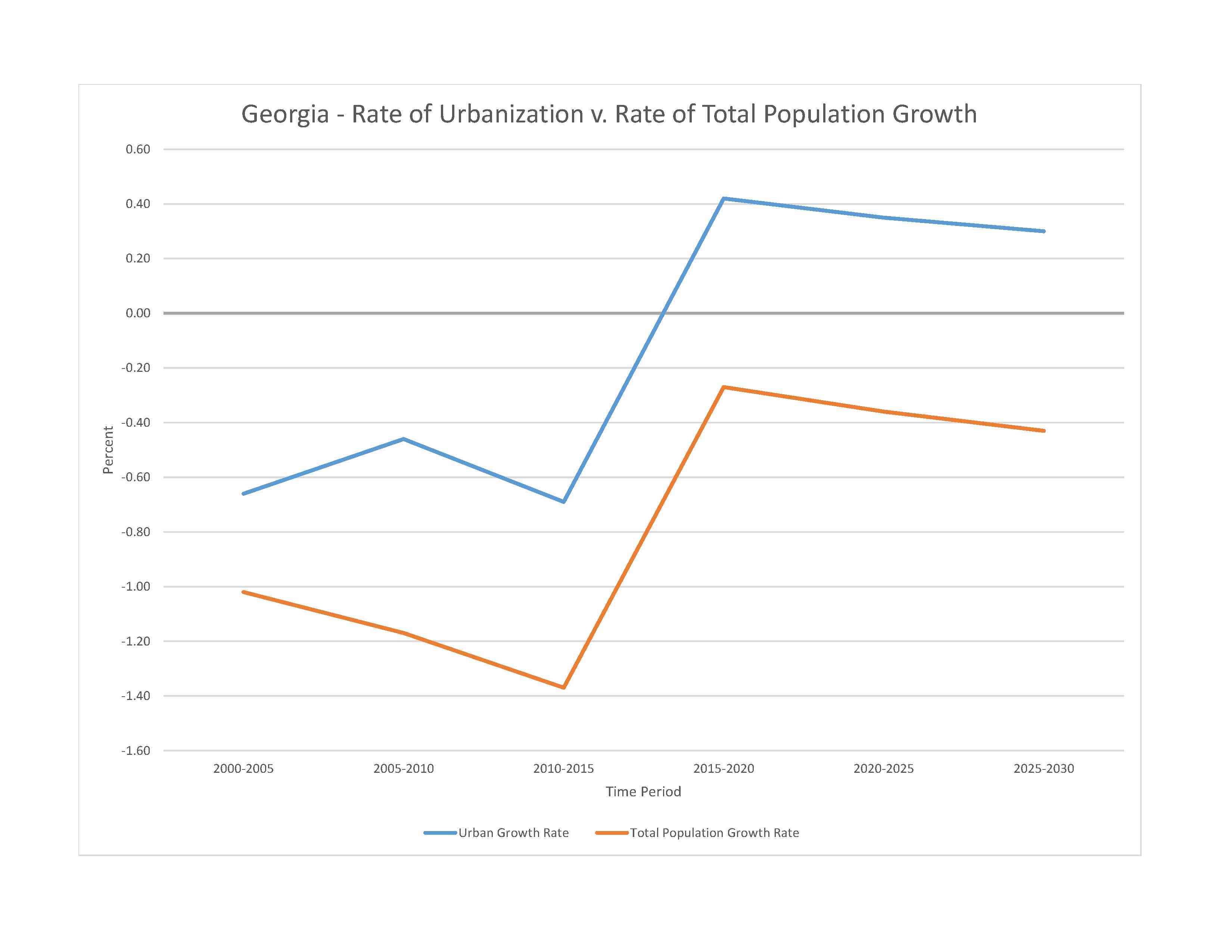
4,927,228 (2023 est.)
noun: Georgian(s)
adjective: Georgian
Georgian 86.8%, Azeri 6.3%, Armenian 4.5%, other 2.3% (includes Russian, Ossetian, Yazidi, Ukrainian, Kist, Greek) (2014 est.)
Georgian (official) 87.6%, Azeri 6.2%, Armenian 3.9%, Russian 1.2%, other 1%; note - Abkhaz is the official language in Abkhazia (2014 est.)
major-language sample(s):
მსოფლიო ფაქტების წიგნი, ძირითადი ინფორმაციის აუცილებელი წყარო. (Georgian)
The World Factbook, the indispensable source for basic information.
Georgian audio sample:
Eastern Orthodox Christian (official) 83.4%, Muslim 10.7%, Armenian Apostolic Christian 2.9%, other 1.2% (includes Roman Catholic Christian, Jehovah's Witness, Yazidi, Protestant Christian, Jewish), none 0.5%, unspecified/no answer 1.2% (2014 est.)
Analyzing population trends in Georgia since independence in 1991 has proven difficult due to a lack of reliable demographic statistics. Censuses were fairly accurately and regularly updated through a vital statistics system during Georgia’s period of Soviet rule, but from independence until about 2010, the system broke down as a result of institutional and economic change, social unrest, and large-scale outmigration. The 2002 census is believed to have significantly overestimated the size of Georgia’s population, in part because respondents continued to include relatives living abroad as part of their household count. The 2014 census indicates that Georgia’s population is decreasing and aging. Census data shows that the median age increased from 34.5 years in 2002 to 37.7 years in 2014. The working-age population (ages 15-65 years) was fairly high in 2002 and rose between 2005 and 2011. Nonetheless, Georgia did not reap economic benefits from this age structure, since the working-age population increase seems to have stimulated labor outmigration to Russia, Ukraine, and other neighboring countries.
Since the Russian invasion of Ukraine in 2022, Georgia has seen its economy grow to its highest level in years due to the influx of Russian businesses, information and communications technology specialists, and money transfers. This growth may only be temporary and conditions could still easily change depending on future events. Meanwhile, the Russian inflow is also a source of concern, as some Georgians fear it could prompt Putin to target their country next. In addition, Ukrainian refugees use Georgia not just as a transit country but also as a destination. Some 25,000 Ukrainians remain in the country as of November 2022; they pose an additional strain on resources in Georgia, which has a significant population of its own displaced citizens – from the 2008 Russian occupation of Abkhazia and South Ossetia – who continue to need government support.
0-14 years: 18.41% (male 468,459/female 440,195)
15-64 years: 63.65% (male 1,543,748/female 1,598,047)
65 years and over: 17.95% (2023 est.) (male 348,822/female 537,119)
total dependency ratio: 55.4
youth dependency ratio: 32.8
elderly dependency ratio: 22.6
potential support ratio: 4.4 (2021 est.)
total: 38 years (2023 est.)
male: 35.6 years
female: 40.4 years
-0.57% (2023 est.)
12.3 births/1,000 population (2023 est.)
13.6 deaths/1,000 population (2023 est.)
-4.3 migrant(s)/1,000 population (2023 est.)
settlement concentrated in the central valley, particularly in the capital city of Tbilisi in the east; smaller urban agglomerations dot the Black Sea coast, with Bat'umi being the largest
urban population: 60.7% of total population (2023)
rate of urbanization: 0.35% annual rate of change (2020-25 est.)
note: data include Abkhazia and South Ossetia

1.082 million TBILISI (capital) (2023)
at birth: 1.07 male(s)/female
0-14 years: 1.06 male(s)/female
15-64 years: 0.97 male(s)/female
65 years and over: 0.65 male(s)/female
total population: 0.92 male(s)/female (2023 est.)
25.9 years (2019 est.)
note: data does not cover Abkhazia and South Ossetia
28 deaths/100,000 live births (2020 est.)
total: 22.6 deaths/1,000 live births (2023 est.)
male: 24.3 deaths/1,000 live births
female: 20.8 deaths/1,000 live births
total population: 72.3 years (2023 est.)
male: 68.3 years
female: 76.6 years
1.96 children born/woman (2023 est.)
0.95 (2023 est.)
40.6% (2018)
improved: urban: 99.4% of population
rural: 94.3% of population
total: 97.3% of population
unimproved: urban: 0.6% of population
rural: 5.7% of population
total: 2.7% of population (2020 est.)
7.6% of GDP (2020)
5.11 physicians/1,000 population (2020)
2.9 beds/1,000 population (2014)
improved: urban: 96.3% of population
rural: 72.7% of population
total: 86.7% of population
unimproved: urban: 3.7% of population
rural: 27.3% of population
total: 13.3% of population (2020 est.)
21.7% (2016)
total: 7.45 liters of pure alcohol (2019 est.)
beer: 1.71 liters of pure alcohol (2019 est.)
wine: 3.19 liters of pure alcohol (2019 est.)
spirits: 2.52 liters of pure alcohol (2019 est.)
other alcohols: 0.02 liters of pure alcohol (2019 est.)
total: 31.7% (2020 est.)
male: 56.3% (2020 est.)
female: 7.1% (2020 est.)
2.1% (2018)
67.1% (2023 est.)
women married by age 15: 0.3%
women married by age 18: 13.9%
men married by age 18: 0.5% (2018 est.)
3.6% of GDP (2021 est.)
definition: age 15 and over can read and write
total population: 99.6%
male: 99.7%
female: 99.5% (2019)
total: 16 years
male: 16 years
female: 16 years (2021)
NOTE: The information regarding Georgia on this page is re-published from the 2024 World Fact Book of the United States Central Intelligence Agency and other sources. No claims are made regarding the accuracy of Georgia 2024 information contained here. All suggestions for corrections of any errors about Georgia 2024 should be addressed to the CIA or the source cited on each page.
This page was last modified 04 May 24, Copyright © 2024 ITA all rights reserved.